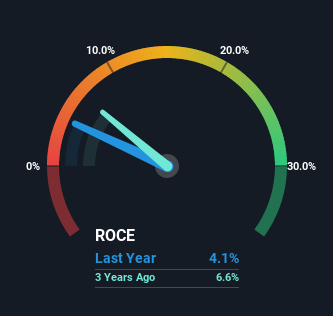- United States
- /
- Electric Utilities
- /
- NYSE:PPL
PPL's (NYSE:PPL) Returns On Capital Tell Us There Is Reason To Feel Uneasy

When we're researching a company, it's sometimes hard to find the warning signs, but there are some financial metrics that can help spot trouble early. More often than not, we'll see a declining return on capital employed (ROCE) and a declining amount of capital employed. Trends like this ultimately mean the business is reducing its investments and also earning less on what it has invested. In light of that, from a first glance at PPL (NYSE:PPL), we've spotted some signs that it could be struggling, so let's investigate.
Understanding Return On Capital Employed (ROCE)
For those who don't know, ROCE is a measure of a company's yearly pre-tax profit (its return), relative to the capital employed in the business. Analysts use this formula to calculate it for PPL:
Return on Capital Employed = Earnings Before Interest and Tax (EBIT) ÷ (Total Assets - Current Liabilities)
0.041 = US$1.5b ÷ (US$38b - US$2.5b) (Based on the trailing twelve months to March 2023).
So, PPL has an ROCE of 4.1%. On its own, that's a low figure but it's around the 4.5% average generated by the Electric Utilities industry.
View our latest analysis for PPL

Above you can see how the current ROCE for PPL compares to its prior returns on capital, but there's only so much you can tell from the past. If you're interested, you can view the analysts predictions in our free report on analyst forecasts for the company.
The Trend Of ROCE
There is reason to be cautious about PPL, given the returns are trending downwards. Unfortunately the returns on capital have diminished from the 8.4% that they were earning five years ago. And on the capital employed front, the business is utilizing roughly the same amount of capital as it was back then. Since returns are falling and the business has the same amount of assets employed, this can suggest it's a mature business that hasn't had much growth in the last five years. If these trends continue, we wouldn't expect PPL to turn into a multi-bagger.
Our Take On PPL's ROCE
In summary, it's unfortunate that PPL is generating lower returns from the same amount of capital. In spite of that, the stock has delivered a 26% return to shareholders who held over the last five years. Regardless, we don't like the trends as they are and if they persist, we think you might find better investments elsewhere.
PPL does have some risks though, and we've spotted 2 warning signs for PPL that you might be interested in.
While PPL may not currently earn the highest returns, we've compiled a list of companies that currently earn more than 25% return on equity. Check out this free list here.
New: Manage All Your Stock Portfolios in One Place
We've created the ultimate portfolio companion for stock investors, and it's free.
• Connect an unlimited number of Portfolios and see your total in one currency
• Be alerted to new Warning Signs or Risks via email or mobile
• Track the Fair Value of your stocks
Have feedback on this article? Concerned about the content? Get in touch with us directly. Alternatively, email editorial-team (at) simplywallst.com.
This article by Simply Wall St is general in nature. We provide commentary based on historical data and analyst forecasts only using an unbiased methodology and our articles are not intended to be financial advice. It does not constitute a recommendation to buy or sell any stock, and does not take account of your objectives, or your financial situation. We aim to bring you long-term focused analysis driven by fundamental data. Note that our analysis may not factor in the latest price-sensitive company announcements or qualitative material. Simply Wall St has no position in any stocks mentioned.
About NYSE:PPL
PPL
An energy company, focuses on providing electricity and natural gas to approximately 3.6 million customers in the United States.
Acceptable track record with imperfect balance sheet.


